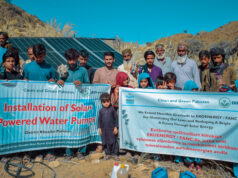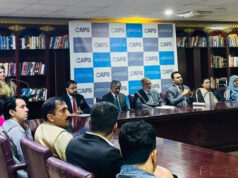Adnan Aamir
Balochistan has been called an information black hole for the better part of the last two decades. It got this unfortunate distinction because of the absence of free media faces in the province. Censorship caused by national security concerns, a financial crisis, and lack of interest in media in Balochistan has culminated in the province becoming a non-issue for the national media paradigm in Pakistan.
The absence of free and balanced media coverage from Balochistan has further exacerbated the state of affairs in the province. Balochistan is facing one of the worst phases of governance, accountability, and imprudent decision making. Local press in Balochistan, funded through government advertisements, cannot be a true mirror of the situation given its dependence on the provincial exchequer for its operations. These circumstances have created a major vacuum for information dissemination in the province, which is being filled by alternative or ‘new’ media.
These rising alternative media include online newspapers, Facebook streaming shows, and YouTube Channels. Over the last two years, there has been a rise in the number of such alternative media which are trying to fill the gap in the media paradigm of the province.
The Baloch Hal, established in 2009, was the first online newspaper from Balochistan. Later it was closed down by its founder Malik Siraj Akbar in 2014. Now there are plenty of online news outlets covering Balochistan such as Balochistan Voices, Balochistan Point, Baloch News, Bolan Tribune, Haal Hawal among others. These online newspapers run without any sound financial backing therefore they face resource scarcity. As a result, they can’t compete with the mainstream media but in aggregation, these newspapers are playing an important role in filling the news vacuum in Balochistan.
Likewise, the trend of Facebook streaming shows and YouTube channels has also kicked off in Balochistan during the last one year. Azadi News, the Urdu newspaper founded by late Siddique Baloch, was the first to start this trend in the province. This was followed by Intekhab and other newspapers of the province. Later on, nationwide web portal Sujag also started its Balochistan forum. Besides, Baloch diaspora also operates a few YouTube channels covering Balochistan.
Moreover, this scribe also hosts a weekly talk show on Facebook and YouTube titled “Live with Adnan Aamir” which covers politics, economy, and society in Balochistan. Many other journalists who are frustrated with the mainstream media are also contemplating similar moves and planning to launch their web shows. This trend has already resulted in the creation of adequate media content on Balochistan which is freely available anywhere in the world.
The rise of the new media is a blessing not only for the populace but also for journalists of the province. This new media has ended the monopoly of mainstream newspapers and TV channels in the province. Previously, the editors of newspapers and controllers of news channels decided which news would make it to the print and on-air respectively. Now, they no longer enjoy this monopoly. Journalists can live broadcasted from anywhere in Balochistan through social media platforms. These live broadcasts along with the flexible production capabilities of online newspapers have made the new media the top choice for the common people as well.
These alternative media platforms have also democratized the flow of media information. Now, the decision about what will be made public or not will be made by the public and not by the chosen few in the mainstream news organizations. This has also helped in countering censorship because it’s easier to control news channels and newspapers as compared to the alternative media which is facing a mushroom growth.
Moreover, new media has also addressed the problem of accessibility of the content. In the past, the distribution of newspapers and the transmission of news channels were not available everywhere. People needed additional equipment to receive a transmission from news channels. Now, the problem has been resolved by the spread of mobile internet across the province. Anyone with a mobile phone and a basic mobile internet can access new media. Currently, the mobile internet is suspended in seven districts of the province, and once this service restored, it will further improve the outreach of the new media.
The rise of new media has also allowed journalists to practice creativity in the way they share news and information. In mainstream media, they had to follow the established methods. With new media, they can practice with different nature of programs, news distribution mechanisms, and so on. For instance, some youngsters are just recording news videos and sharing them on WhatsApp to take advantage of the outreach of the messaging app in the province.
Furthermore, the advent of new and alternative media is not sans problem. Even today there is no sustainable revenue model for these news platforms. The journalists running them use freely available services on social media. They give their time but do not get any financial incentive in return. Therefore, this approach is not financially sustainable and it cannot continue without problems in the long run.
Likewise, since the flow of information is now under the control of the public, this situation brings certain problems with itself. While there are some responsible journalists with knowledge of the basics of journalists, there are many others who are using the new media for their vested interests. They use such platforms for mudslinging on others and sharing fake news. Given the nature of the new media, there is no way to control this evil.
Also, using the same argument, the government is also trying to censor the entire new media paradigm in the name of moral and ethical policing. In the past, PEMRA has issued absurd provisional instructions whereby journalists will be required to pay Rs10 million to register their web channels. Government regulation is a hanging sword on the new media for now.
Notwithstanding its downside and the potential problems, new media is a blessing for peripheral regions like Balochistan. In the interests of freedom of expression and free media, journalist’s bodies, political parties, and citizen groups should throw their weight behind the new media. Only this sort of unrelenting support from different sections of the society can help the new media survive in an otherwise predatory environment.
Originally published in Balochistan Voices.
Share your comments!








